Gas holder for a summer residence: mini options for arranging summer cottages
Not all summer cottages are provided with centralized gas supplies. To heat a house with electricity is expensive. A good alternative is autonomous gasification. If the group of cylinders is not satisfied, then the gas tank, a special tank that is filled with a mixture of liquefied hydrocarbons, will be the way out.
We will help you choose the best gas holder for your summer residence. In the article we presented, all varieties actively exploited in suburban areas are described in detail. A detailed description of the models will give an idea of the features of the installation and use of tanks for autonomous gas supply.
The content of the article:
Features of the installation of the gas tank
A gas holder is not only a container for storing the fuel mixture, but also a place where the liquid phase goes into a gaseous state for further supply to the heating main under constant pressure. An important point in the construction of an autonomous gas system is the competent choice of a gas tank, for which a calculation of its technical parameters is needed.
To determine the volume of the tank, the heated area is multiplied by the average amount of fuel consumed by boilers with an efficiency of 60 to 70%. It is approximately 17 liters for winter, when there are few days with very low temperatures.
If the winters are stably severe in the region or there are underfloor heating in the country, the pool, the water in which you need to heat up, the estimated volume is increased. In summer or in the off-season, 3.3 liters is enough to heat 1 m².
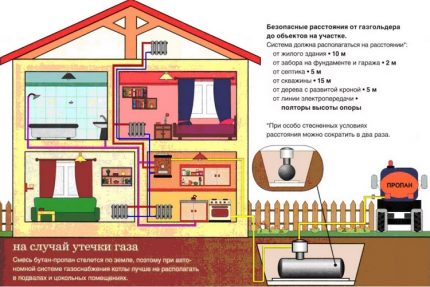
For the operation of a mini-gas tank or tank, the volume of which does not exceed 10 tons.l, no permission from Rostekhnadzor is needed, provided that the requirements of SNIP regarding installation are met, and the power of heating devices is not more than 100 kW. If this capacity does not suit you and you need to exceed it, then you will have to get a permit.
It is also not necessary to ask for consent from the owners of neighboring plots if communications will not take place in the immediate vicinity of the boundary. In any case, in order to avoid all kinds of misunderstandings, it is good to have a quality certificate on hand. It must be taken at a company that sold equipment and has a license to install it.
The main components of the gasification project
Not every place on the site is suitable for installing a propane-butane tank. For all conditions to be met, it must have the appropriate dimensions. The main thing is that a free access to the tank is needed, otherwise it becomes impossible to refuel and service it.
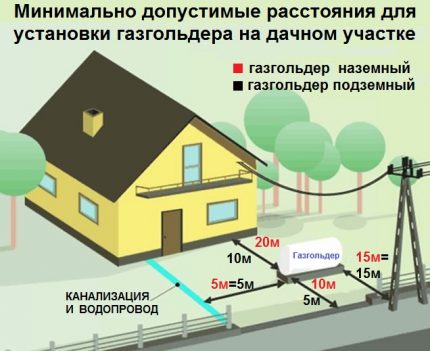
All communications can only be laid underground. The container itself should not be under a driveway or other road.
The optimal distance from the road to the reservoir is 5 m. At least 8 m should be retreated from household buildings on your site. To the foundation of the house is 10 m, and 20 m from the neighbor’s house. The plate with factory data should be in sight. Rules for choosing a location for the gas tank given in the articlededicated to this issue.
It is allowed that the installed tank rises above the ground by a maximum of 0.6 m. It must be earthed, and if static voltage is present on the site, measures must be taken to protect against electrochemical corrosion.
In terms of autonomous gasification consists of a tank manufactured and passed all stages of tests in the factory, pressure regulators, protection, gas pipeline. The protection consists of electrodes made of magnesium located at a distance of about 0.35 m from the tank. The purpose of the condensate collector is to collect liquid butane, which then evaporates by itself.
The gas pipeline is collected from pressure polyethylene pipes. Gas pipeline before entering the house, mounted from metal pipes and equipped with a shut-off valve, and a bellows type compensator. The internal pipeline is equipped with thermal shutoff valves.
For gas tank dives prepare a pit, at the bottom of which a pillow of sand and gravel is arranged. Next, pour a monolithic base with a height of at least 160 mm. Without this, the unit can be squeezed out of the pit by groundwater. Sometimes the tank is immediately fixed on the finished reinforced concrete slab, and then all together they are lowered into the pit.
After fixing the tank, it is coated with a special lubricant that protects the metal from corrosion. The next stage is the anode-cathode protection device. After that, they lay the gas pipeline, fill it and the pit with soil.
Types of gas holders for giving
Gas holders for autonomous gasification suburban areas are both stationary and mobile. Fixed-type tanks are divided into aboveground and underground. For a house where they live permanently, a stationary tank is more suitable, and in the case of a cottage intended for seasonal use, it is rational to use the mobile option.
Ground Mount Models
Ground-based gas tanks are characterized by ease of installation, since excavation is not required. The reason for the unpopularity of this option is the fact that the fuel mixture evaporates very slowly at low temperature. Therefore, the tank must not only be insulated, but also equipped with evaporators.

This is not rational for one country house, but if a large-capacity tank is used to provide fuel for the whole country house, this option is better. This is due to the fact that the decision to dig a gas holder with a volume of up to 6 t. M² into the earth will cost much more.
Underground Options
Underground tanks are placed in the ground below the freezing point.
This solution has advantages:
- site design does not suffer;
- there is no need for additional equipment that supports the stable evaporation of the gas mixture.
Underground tanks are used to supply gas to a village consisting of several houses. During underground installation of the gas tank, the minimum distance from the ground level to the top point of the tank is an average of 0.6 m. This parameter is greatly influenced by the climatic conditions of the area.
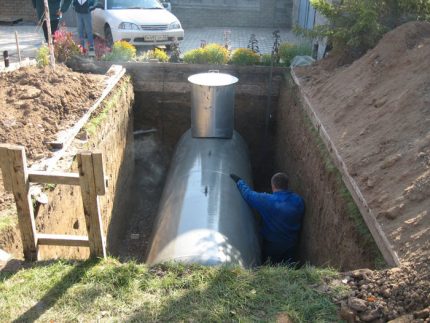
Quality gas tank for underground installation must be equipped with a high neck, which will allow it to be placed at the required depth. This will facilitate the task of periodically checking the walls of the tank and welds for strength.
The tank must have a wall thickness of 6 mm minimum and the thickness of the anticorrosive epoxy polymer shell is not less than 1 mm. The seller of the tank must present a certificate confirming that the product meets all the requirements, as well as the permission of Rostekhnadzor for its use.
The process of installing a gas tank with immersion in the ground includes a number of standard steps:
Features of mobile gas tanks
Mobile tank with a volume of about 500 m3 placed on a caravan. Connecting such a gas tank to the gas line is not difficult, and they perform this operation very quickly.
In fact, this is the same gas cylinder, only of a larger volume and having a gas heating system. This amount of liquefied fuel can heat a small cottage during the winter.
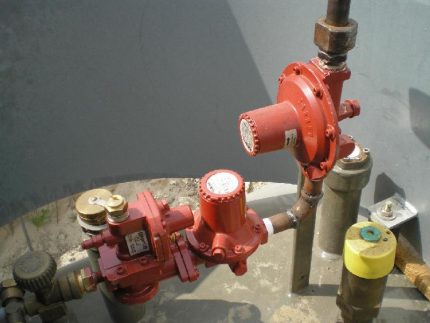
Such mini-tanks are compact - about 2 m long and 0.6 m in diameter. Their service life is quite long - up to 25 years.
If gas is needed exclusively for cooking, then this amount mobile gas tank enough for 2 years. To use the house year-round, you need a tank with a capacity of 2.5 tons, but when you also need to heat household buildings, the size of the storage will have to be increased.
Mini tanks and their advantages
If we compare a miniature gas tank with a volume of 500 or 1000 liters with its large analogue, then the following advantages can be noted:
- It is much cheaper, so it has a shorter payback period.
- You can install it yourself.
- The container does not need to be hidden in the ground, and this significantly reduces the installation time.
- There are no strict requirements for the installation site. Clause 8.2.3. SP 62. 13330. 2022 states that you can place a mini-tank directly against the wall of the house.
- Gasification using such a gas tank is very fast - it will take only about 2 hours.
There are many pluses in the case of comparison with a conventional gas cylinder. The main thing is that the gas tank is not explosive. The valves included in its configuration do not allow pressure increase above the established norm.
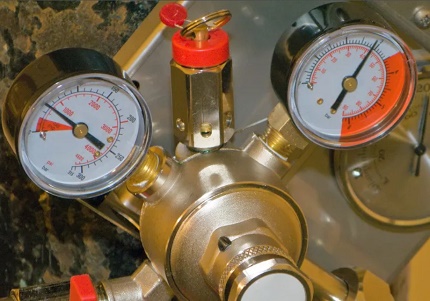
To replenish the gas mixture it is not necessary to visit a gas station. If the gas holder is not installed on the caravan, but simply on the site near the house, then it is possible to refuel it in place.
Unlike a cylinder, it can supply gas not only to a stove, but also to other more powerful equipment. Due to the fact that the tank has a level gauge, you can always find out how much mixture is left in it.This allows you to pre-schedule refueling.
Vertical gas installations
Depending on the design features, underground gas holders for arranging cottages are divided into horizontal and vertical, occupying 3 times less space than horizontal ones.
This option is well suited for suburban housing, with a small local area. Ideally, when it has a high neck, then it is buried to a depth of approximately 4 m. This will help to avoid gas condensation during cold weather.
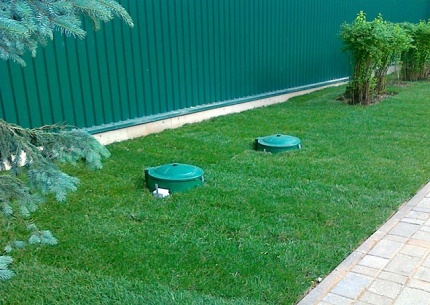
While the area of gas evaporation decreases with fuel consumption from a horizontal tank, in a vertical gas tank, when the mixture level drops, the mirror area remains constant.
Despite the lower productivity, this is a serious advantage, but due to the considerable height of the tank and the depth of freezing of the earth, it will take a lot of effort to prepare a place for it.
Models of this type are suitable for country houses, the area of which does not exceed 150 m². Good vertical gas tanks are produced in Italy, in particular those produced by the company Antonio Merloni. They are equipped with a heat-protective layer that allows you to keep a stable temperature during extreme cold.
Vertical tanks of the company from Bulgaria CITI GAS are also popular. The lineup consists of capacities of 2700, 4800 and 6400 gas-liters. The gas holders of these two companies differ not only in volume, but also in the color of the tanks and the brand names on them.
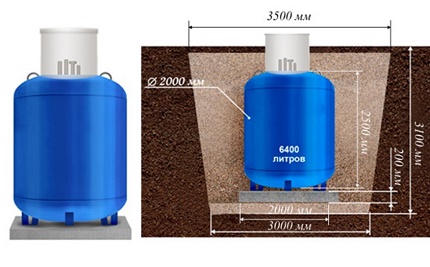
The cost of vertical tanks is higher than that of horizontal samples. They effectively supply the gas mixture in the temperature range -40 - + 40 +. Their service life is 30 years.
Horizontal gas tanks
Horizontal gas tanks are more productive than vertical ones. There is one caveat - this indicator is unstable. As soon as the level of the gas mixture drops to 1/3 of the volume, it begins to fall, so the system cannot function stably without a special gearbox.
Horizontal tanks are effective for heating a house with an area of 200 m² or more at once. To install a horizontal tank, a pit of small depth is prepared.
Its volume should be taken 20% more from the estimated fuel demand. This is necessary so that the gas is sufficient to maintain productivity after reducing its volume to a critical value.

The metal body of the gas holder can withstand pressure not higher than 1.8 MPa. Antonio Merloni is also the leader among manufacturers of horizontal units.
There are also units of the Czech company Deltagaz, the Polish Chemet, on the market. The normal functioning of these tanks is possible even in unusual situations and during the most severe winters.
Detailed characteristics of gas tanks of domestic, Czech and Italian production given here. We recommend that you familiarize yourself with useful information.
Features of refueling gas tanks with a mixture of gases
The frequency of filling tanks with propane-butane depends on their volume and on how intensively it is used. On average, it is 1-3 times a year. The main thing is not to miss the moment when the balance will be about 30%. They fill the tank not to the top, but not more than 85%.
The gas mixture supplier must be licensed and have special transport. The easiest way is to fill in mobile modifications of mini gas tanks for servicing cottages, since they can be transported on a car trailer. Before filling the gas tank, the indicators of the devices must be checked.
Introduces the cost of installing a gas tank on a private site next articlewhich we recommend reading.
Conclusions and useful video on the topic
Video # 1. About gas holder installation technology:
Video # 2. About mobile gas tanks:
The purchase and installation of any gas tank must be preceded by calculations of its volume, the payback time of the unit. The calculation results must be compared with alternative types of heating and only then make a decision.
Do you want to share the personal experience gained during the installation and operation of the gas tank in your suburban area? Do you have information that will be useful to site visitors? Please write comments in the block below, ask questions, publish thematic photos.

 Gas tank Antonio Merloni (Antonio Merloni): lineup and equipment selection criteria
Gas tank Antonio Merloni (Antonio Merloni): lineup and equipment selection criteria 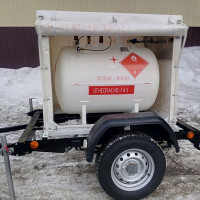 Mobile gas tank: purpose, design and installation features, placement requirements
Mobile gas tank: purpose, design and installation features, placement requirements 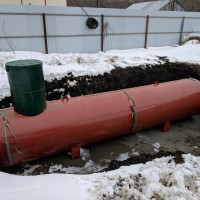 Frozen gas holder: common causes and ways to quickly fix the problem
Frozen gas holder: common causes and ways to quickly fix the problem  Gas heating with a gas tank - is it worth it? Overview of all the nuances, advantages and disadvantages of such a solution
Gas heating with a gas tank - is it worth it? Overview of all the nuances, advantages and disadvantages of such a solution 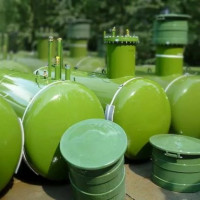 Varieties of gas holders: the basics of classification + an overview of popular brands
Varieties of gas holders: the basics of classification + an overview of popular brands 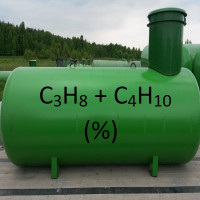 Winter and summer gas - what is the difference? Which gas is better to use for refueling gas tanks
Winter and summer gas - what is the difference? Which gas is better to use for refueling gas tanks  How much does it cost to connect gas to a private house: the price of organizing gas supply
How much does it cost to connect gas to a private house: the price of organizing gas supply  The best washing machines with dryer: model rating and customer tips
The best washing machines with dryer: model rating and customer tips  What is the color temperature of light and the nuances of choosing the temperature of the lamps to suit your needs
What is the color temperature of light and the nuances of choosing the temperature of the lamps to suit your needs  Replacement of a geyser in an apartment: replacement paperwork + basic norms and requirements
Replacement of a geyser in an apartment: replacement paperwork + basic norms and requirements